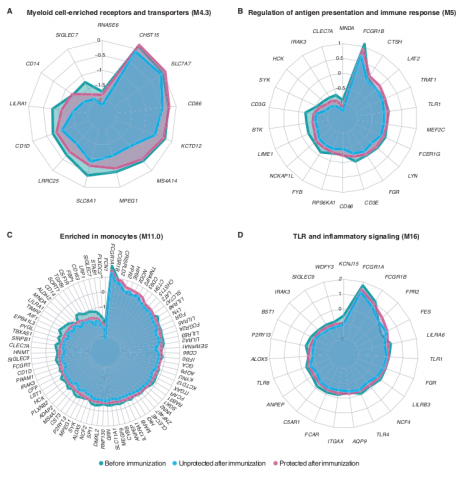Antigen-stimulated PBMC transcriptional protective signatures for malaria immunization

Moncunill G , Scholzen A, Mpina M, Nhabomba A, Bouyoukou Hounkpatin A, Osaba L, Valls R, Campo JJ, Sanz H, Jairoce C, Williams NA, Pasini EM, Arteta D, Maynou J, Palacios L, Duran-Frigola M, Aponte JJ, Kocken CHM, Todagbe Agnandji S, Mas J, Mordmüller B, Daubenberger C, Sauerwein R, Carlota Dobaño C, Identifying immune correlates of protection and mechanisms of immunity accelerates and streamlines the development of vaccines. RTS,S/AS01E, the most clinically advanced malaria vaccine, has moderate efficacy in African children. In contrast, immunization with sporozoites under antimalarial chemoprophylaxis (CPS immunization) can provide 100% sterile protection in naïve adults. We used systems biology approaches to identifying correlates of vaccine-induced immunity based on transcriptomes of peripheral blood mononuclear cells from individuals immunized with RTS,S/AS01E or chemoattenuated sporozoites stimulated with parasite antigens in vitro. Specifically, we used samples of individuals from two age cohorts and three African countries participating in an RTS,S/AS01E pediatric phase 3 trial and malaria-naïve individuals participating in a CPS trial. We identified both preimmunization and postimmunization transcriptomic signatures correlating with protection. Signatures were validated in independent children and infants from the RTS,S/AS01E phase 3 trial and individuals from an independent CPS trial with high accuracies (>70%). Transcription modules revealed interferon, NF-κB, Toll-like receptor (TLR), and monocyte-related signatures associated with protection. Preimmunization signatures suggest that priming the immune system before vaccination could potentially improve vaccine immunogenicity and efficacy. Last, signatures of protection could be useful to determine efficacy in clinical trials, accelerating vaccine candidate testing. Nevertheless, signatures should be tested more extensively across multiple cohorts and trials to demonstrate their universal predictive capacity.
Science Translational Medicine,
2020, 12
Pubmed: 32404508
Direct link: 10.1126/scitranslmed.aay8924
